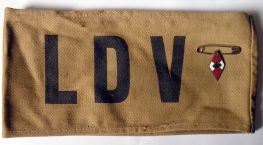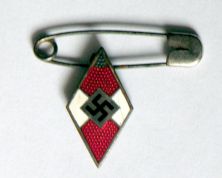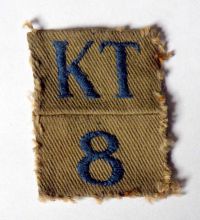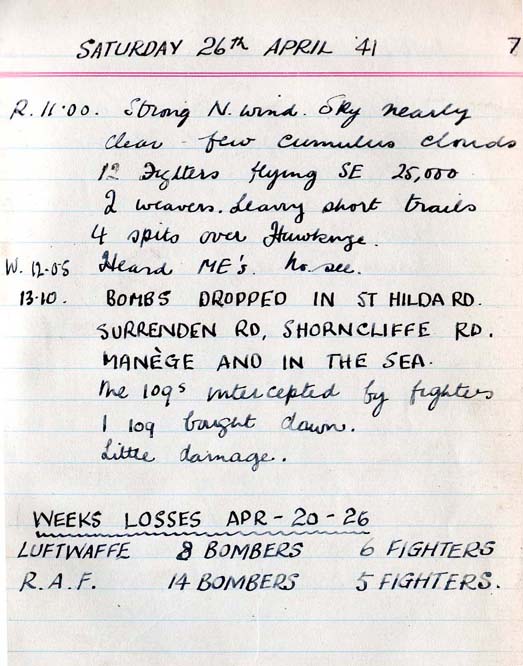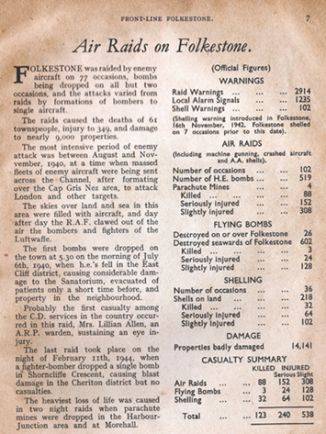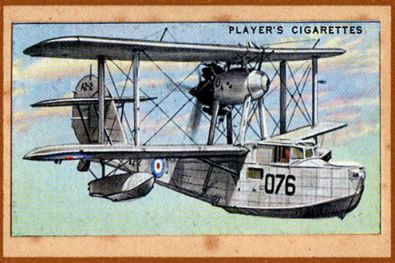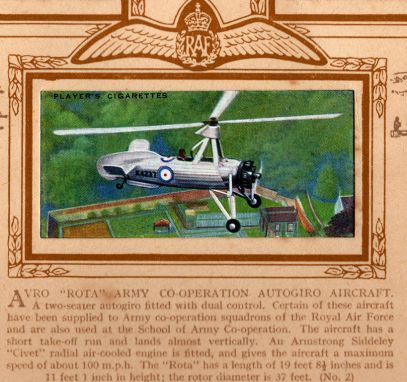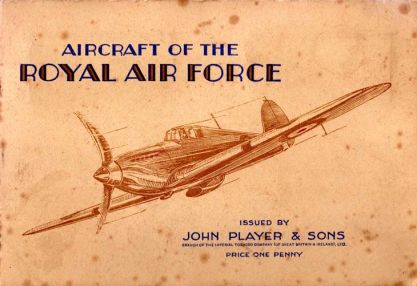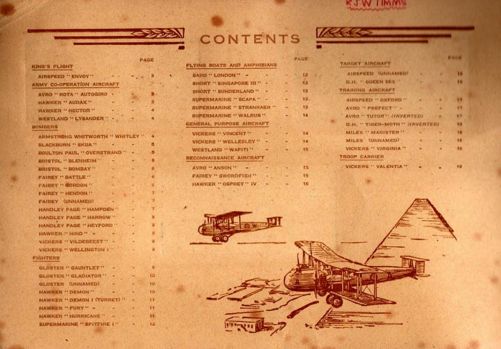| Spotters Log
Rod was very keen on Aircraft and air-spotting. He maintained his own log throughout the period September 3 1939 until joining the Navy on September 10th 1941. During this period he was employed by the Folkestone Electricity Supply Company Limited. Like many people during the war Rod had other duties at work. He was a qualified First Aid worker and appointed as the Fire Watcher and Air-spotter for the works. He always kept a personal diary with daily entries. Rod developed his First Aid skills during his Sea Scout days in Sandgate when he acquired his Kings Scout badge.
He listed his duties relating to Air Raids.
Yellow Warning:- Pre warning – not for public use.
Red Warning:- Me to go on duty (watch) on roof. Public sirens sounded.
Blue Warning:- Sounded by me on local klaxons – to proceed to shelters at the double, danger imminent.
Cuckoo Siren:- Shelling has commenced.
White:- All clear
Folkestone, Dover and the southeast coast were frequently shelled by very large calibre German cross channel guns the Cuckoo siren was used on these occasions.
The first entry in Rod’s war diary was unsurprisingly on the 3rd Sept 1939 “War declared on Germany. 11.15 am First Air Raid warning of the war!”
Early entries included “Mon 30 October Air raid warning 0905 – 0925 On duty FAP” (First Aid Post)
Rod’s entry for Mon 11th March 1940 records “Convoy with Monitor in Channel. Hurricane crashed on Golf Links – immediately caught fire – visited with Engine – still on fire – pilot burnt.”
Rod mentions in his diary “Wed 15th May 1940 – Signed on as ‘Local Defence Volunteer’ this was later to become the ‘Home Guard’”
From the Wednesday 22nd to Sunday 26thMay ‘40 Rod mentions “Wed 22 May Yellow warnings all day – Air raid sirens – Aeroplanes, bombs dropped – Barrage balloons adrift – GERMANS AT AMIENS & COAST – Sirens off at midnight.” “Thurs 23 May Air raid warning from 0630 - 0730 – Smoke coming from CALAIS. BOULOGNE captured – Gunfire and bombs all day.” “Sun 26 May GERMANS AT CALAIS – Huge smoke cloud over Calais.” The French coast can be seen from Folkestone with the naked eye when visibility is good. Using the binoculars Rod was given much more detail could be seen. The threat of invasion was changing from a possibility into a probability as the activity of the Germans could be seen from the English coast!
Rod, now 18 was part of the LDV later to be called the Home Guard (known to us as ‘Dads Army’. His log informs us that on Sat 18thJune 1940 he was on LDV duty between 9am to 12 midday.
"The Home Guard" badge on the left was the first issued and has the writting "painted" on, the badge on the right was a latter one with the writting embroidered on. Pictured below is his initial LDV armband. The small badge shown with the armband is not associated with the armband, I think that it was attached to prevent it from getting lost.
The badge comes from a Scout Jamboree in Holland Rod attended during the 1930's, it is small only measuring 2.5cm x 1.5cm.
I assume that the above badge indicates that my father was in the Kent "Regiment" of the LDV and the 8 relates to a sub-section of that. |
“Fri 5 July ‘40 Saw Spitfire & HE 112 fighting – many tracer bullets – Sandgate raid – Saw HE 111K shot down by 3 Spitfires - Much AA fire.”
“Mon 8 July ‘40 Many sirens – Down in shelters at Power Station – Won sweepstake.” Many hours were spent in shelters in Kent Coastal towns during 1940, as they were not only subjected to countless bombing raids but also cross-channel shelling sometimes on a daily basis. It was important to keep morale up at this time, obviously one of these activities included running a sweepstake!
Many entries listed the roads in Folkestone that were bombed. “ Mon 12 Aug ‘40 Folkestone bombed – Millfield & Shorncliffe Road etc, heard whistle beforeexplosion (some days later it was reported that these were shells fired from guns near Calais/Boulogne. Lympe aerodrome bombed – Terrific raid on Hawkinge and Lympne Aerodrome and Folkestone, HE and Incendiary bombs – down in shelters – dive bombing on Hawkinge by Ju 87’s – overhead electricity cables cut – 5 air raid warnings, a record to date.”
Three days later Rod (unwisely) visited Hawkinge to view the damage he writes on the 15th“Visited Hawkinge, terrible damage, sirens went while we were there, another raid, got out fast. Watched Ju 87’s dive bomb the airdrome. Watched fights – 3 planes down in flames – parachutes. Ju 87 crashed in flames in Shorncliffe Cresent – Plane on fire - I arrived first, pilot on fire in cockpit – got small oxygen cylinder and 16 bullets. Afternoon saw over 80 bombers – bombs in Cheriton and Sandgate – electricity grid down.”
“FRONT-LINE Folkestone” on page 55 under Dates to Remember reports that on the 12th August First bombardment of Folkestone by guns on French coast at Calais; damage but no fatal casualties. Two waves of bombers drop many bombs in tea-time raid; Black Bull and East Cliff districts hit; over 100 bombs on Golf Course.
There are many suchlike entries during 1940 and 1941. There are a couple of photos on page entitled “1939 and 1940” on this website that show incendiary bombs dropped while Rod was staying at a YHA, his notes for Sat 14 Sept ‘40 chronicle the event.
“Mon 30 Sept ‘40 HOOTERS & KLAXON FITTED UP IN WORKS – ALARM SWITCHES ON ROOF SHELTER AND ON TANKS ETC.”
|
“Tues 1 Oct APPOINTED OFFICIAL SPOTTER AND COMMENCED SPOTTING – Raids all day”
During October 1940 the log mentions many raids and lists some of the roads that were bombed, these include Earls Avenue, Dover Road, Tontine Street, Folly Road, Grove Road, Wilton Road, Reviera Sandgate, Dawson Road, Railway Bell, Warren Road, Martello Road, Martin Walters, Sandgate Road, Grimston Gardens, East Cliff, Castle Hill Avenue, Marine Cresent, on railway and Grove Road. Two other incidents itemised during October include “Sun 27 Oct ‘40 Was after chestnuts in Paraker Woods – got bombed!! – bombs in woods very close – visited crater and collected bomb fragments they were very hot – got burnt fingers! – took photos.”
Rod saw Italian planes over Folkestone for the first time in the war on the 29 Oct, his entry for the day doesn’t identify the type of plane but he subsequently lists the FIAT BR 20 CICOGNA and the FIAT CR 42 FRECCIA in his “Enemy Planes seen during 1940” record.
On Sat 9 Nov ‘40 Rod recalls how Bombs fell in Cheriton High Street and Broomfield Road and continues with “ran up road – first there – got woman out of rubble – did first aid – not badly injured.” The Electricity Works was nearby.
Rod lived in Sandgate during the war, on Sun 16 Feb ‘41 he mentions that a Mine exploded at Sandgate causing widespread damage and blowing blackouts down. Busses had to be diverted up Military Hill.
Page from Rod's Spotter's Log showing typical day's entry and government supplied "Weeks Losses"
The losses of aircraft on both sides were enumerated in Rod’s journal, the week’s losses for May 4 – 10 1941 for the Luftwaffe show 106 Bombers with 34 Fighters and for the RAF show 27 Bombers with 13 Fighters. This shows a marked difference over the last few months. A number of the above Luftwaffe planes were accounted for on the night of Sat 10th when according to Rod 33 bombers were shot down over London. Incendiary bombs were dropped on East Cliff and Bouverie Road. An earlier entry for the end of April comments that an ME 110 was spotted over Folkestone, the first for some considerable time. Part of the entry for the 10th Rod catalogues the fact that HESS LANDS IN SCOTLAND IN ME 110.
On May 16th Rod was on the roof of the Electricity Works on duty during a raid lasting from 13.15 to 1405. He tells us that “4 ME109f’s dived on Hawkinge from the north, much cannon fire - passed overhead at no more than 100 feet – very good view – all yellow nosed – saw pilot in cockpit and squadron insignia on engine cowling – a curved snake horizontal – closest been to an ME flying.”
While on Home Guard duty in the early morning of the 29thMay 41 two parachute mines dropped in Morehall Avenue and Cherry Garden Avenue killing 13 people including the Mayor and Mayoress of Folkestone named in Front-line Folkestoneon page 60 as Alderman and Mrs Gurr. Rod writes “I was on Home Guard duty about 150 yards away – windows blown in and blackouts blown down – much illumination as people switched on lights. Went to point of explosion outside off-licence in Shorncliffe Road – gutters running with wines and beer – emergency services arrived. A rather frightening experience – a very loud explosion.”
Page 7 from "Font-line Folkestone"
The Log’s entry for Sat June 22nd 1941 explains why less and less records are entered. “Sky clear – slight breeze – very hot. Sweeps over France, 32 Nazi Planes down, 2 RAF. GERMANY INVADES RUSSIA. Many German aircraft moved to Eastern Front.
In between the June 22 entry and Sept 5 entry Rod’s log was only written in when a sighting took place. The only entry recording a sighting of enemy aircraft was on the 1st Sept when he mentioned “1530 Slight NE wind, visibility good, cirro-cumulus, Spits on patrol. 2 Messerschmitt 109e’s from SW direction flew over to Dover, height approx 12,000 feet. First enemy aircraft seen in daytime over works since June 16th.”
Vickers Supermarine Walrus (card No 34)
An interesting observation made on the 21st July was “11.25 Douglas Boston landed at Hawkinge. Auto-Giro over town. Vickers Supermarine Walrus circled and landed at Hawkinge. No raids.” For those of you reading this now an Auto-Giro was the fore-runner of the modern helicopter, seeing a helicopter now is an almost daily occurrence. In July 1941 it was a very rare sighting.
Avro "Rota" Autogiro (card No 2)
The final record reads “16.25 Slight wind – NNW visibility poor, hazy – 2 Tomahawks over Hawkinge. LOG COMPLETED, LEFT EMPLOY OF FOLKESTONE ELECTRICITY COMPANY LTD – JOINED ROYAL NAVY SEPT 10TH 1941.”
The images of aircraft come from one of Rod’s “cigarette card” albums. I am unsure of the exact date of the album but the latest date mentioned in the card descriptions is 1938 so I imagine that it is 1938 or 1939.
Rod used his two copies of R A Saville-Sneath's AIRCRAFT RECOGNITION "A Penguin Special" as his Spotters bible throughout his later spotting time. Although in very poor condition I still have both of the original copies.
|



